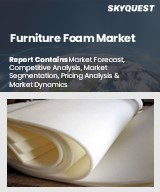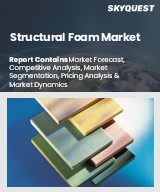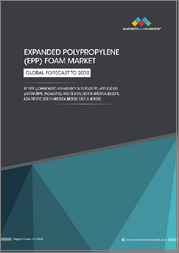
|
시장보고서
상품코드
1838233
세계의 가구용 폼 시장 : 규모, 점유율, 성장 분석 - 유형별, 용도별, 소재 유형별, 최종 사용자별, 지역별 산업 예측(2025-2032년)Furniture Foam Market Size, Share, and Growth Analysis, By Type (Polyurethane Foam, Memory Foam), By Application (Residential Furniture, Commercial Furniture), By Material Type, By End-User, By Region - Industry Forecast 2025-2032 |
||||||
세계의 가구용 폼 시장 규모는 2023년 561억 달러로 평가되었고 예측기간 중(2025-2032년) CAGR은 6.2%로 확대되어, 2024년 595억 8,000만 달러에서 2032년에는 964억 달러로 성장할 전망입니다.
세계의 가구용 폼 시장은 쾌적하고 내구성이 뛰어나고, 커스터마이징 가능한 폼 기반 가구에 대한 수요가 주택, 상업, 시설의 각 분야에서 높아지고 있음을 배경으로 강력한 성장을 이루고 있습니다. 쿠션성과 내구성과 같은 폼의 본질적인 특성은 매트리스나 오피스의 좌석 등 쾌적성을 중시한 제품에 필수적이며, 디자인 혁신으로의 길을 열고 있습니다. 도시화와 가정 장식품에 대한 소비 지출 증가 등의 요인이 시장 확대를 더욱 뒷받침하고 있습니다. 그러나 원재료 비용의 변동이나 환경 문제에 대한 우려가 과제가 되고 있어, 제조업체 각사는 바이오 베이스나 리사이클 소재를 사용하는 등, 환경에 배려한 제품의 개발을 진행하고 있습니다. 게다가 가구와 실내 장식품의 전자상거래의 상승, 접객와 헬스케어 등의 분야의 성장이 새로운 기회를 만들어 발포제품 수요를 촉진하고 있습니다.
자주 묻는 질문
목차
소개
- 조사의 목적
- 조사 범위
- 정의
조사 방법
- 정보 조달
- 2차와 1차 데이터의 방법
- 시장 규모 예측
- 시장의 전제조건과 제한
주요 요약
- 세계 시장 전망
- 공급과 수요 동향 분석
- 부문별 기회 분석
시장 역학과 전망
- 시장 개요
- 시장 규모
- 시장 역학
- 성장 촉진요인과 기회
- 억제요인과 과제
- Porter's Five Forces 분석
주요 시장 인사이트
- 중요성공요인
- 경쟁도
- 주요 투자 기회
- 시장 생태계
- 시장의 매력 지수(2024년)
- PESTEL 분석
- 거시경제지표
- 밸류체인 분석
- 가격 분석
가구용 폼 시장 규모 : 유형별, CAGR(2025-2032년)
- 시장 개요
- 폴리우레탄 폼
- 메모리 폼
- 라텍스 폼
- 반발 폼
- 기타 폼
가구용 폼 시장 규모 : 용도별, CAGR(2025-2032)
- 시장 개요
- 주택 가구
- 업무용 가구
- 자동차 및 운송
- 기타 용도
가구용 폼 시장 규모 : 소재 유형별, CAGR(2025-2032)
- 시장 개요
- 석유계 폼
- 바이오 베이스 폼
- 하이브리드 폼
가구용 폼 시장 규모 : 최종 사용자별, CAGR(2025-2032)
- 시장 개요
- 주택 소유자
- 주거용 소비자 및 기업
- 상업 고객
가구용 폼 시장 규모, CAGR(2025-2032)
- 북미
- 미국
- 캐나다
- 유럽
- 독일
- 스페인
- 프랑스
- 영국
- 이탈리아
- 기타 유럽
- 아시아태평양
- 중국
- 인도
- 일본
- 한국
- 기타 아시아태평양
- 라틴아메리카
- 브라질
- 기타 라틴아메리카
- 중동 및 아프리카
- GCC 국가
- 남아프리카
- 기타 중동 및 아프리카
경쟁 정보
- 상위 5개사 비교
- 주요 기업의 시장 포지셔닝(2024년)
- 주요 시장 기업이 채용한 전략
- 최근 시장 동향
- 기업의 시장 점유율 분석(2024년)
- 주요 기업의 기업 프로파일
- 기업의 상세
- 제품 포트폴리오 분석
- 기업의 부문별 점유율 분석
- 수익의 전년대비 비교(2022-2024년)
주요 기업 프로파일
- BASF SE
- The Dow Chemical Company
- Huntsman International LLC
- Carpenter Co.
- Recticel
- Future Foam, Inc.
- Sheela Foam Ltd.
- Flexible Foam Products Inc.
- Foamcraft Inc.
- EPE International Ltd.
- Vitafoam Nigeria Plc
- Raunak Group
- Foam Products Corporation
- Cenflex
- COZILY
- Master Foam
- American Foam Products Inc.
- GIANTEX
- Forever Enterprises
- FEBERICA
결론과 권고
JHS 25.10.22Global Furniture Foam Market size was valued at USD 56.1 billion in 2023 and is poised to grow from USD 59.58 billion in 2024 to USD 96.4 billion by 2032, growing at a CAGR of 6.2% during the forecast period (2025-2032).
The global furniture foam market is witnessing robust growth driven by an increased demand for comfortable, durable, and customizable foam-based furniture across residential, commercial, and institutional sectors. Foam's essential properties, such as cushioning and durability, make it integral to comfort-focused products like mattresses and office seating, paving the way for design innovations. Factors such as urbanization and heightened consumer spending on home decor are further propelling market expansion. However, challenges related to fluctuating raw material costs and environmental concerns are prompting manufacturers to adopt eco-friendly practices, using bio-based and recycled materials. Additionally, the rise of e-commerce in furniture and home decor, along with growth in sectors such as hospitality and healthcare, is creating new opportunities and driving demand for foam products.
Top-down and bottom-up approaches were used to estimate and validate the size of the Global Furniture Foam market and to estimate the size of various other dependent submarkets. The research methodology used to estimate the market size includes the following details: The key players in the market were identified through secondary research, and their market shares in the respective regions were determined through primary and secondary research. This entire procedure includes the study of the annual and financial reports of the top market players and extensive interviews for key insights from industry leaders such as CEOs, VPs, directors, and marketing executives. All percentage shares split, and breakdowns were determined using secondary sources and verified through Primary sources. All possible parameters that affect the markets covered in this research study have been accounted for, viewed in extensive detail, verified through primary research, and analyzed to get the final quantitative and qualitative data.
Global Furniture Foam Market Segments Analysis
Global Furniture Foam Market is segmented by Type, Application, Material Type, End-User and region. Based on Type, the market is segmented into Polyurethane Foam, Memory Foam, Latex Foam, Rebounded Foam and Other Foams. Based on Application, the market is segmented into Residential Furniture, Commercial Furniture, Automotive & Transportation and Other Applications. Based on Material Type, the market is segmented into Petroleum-based Foam, Bio-based Foam and Hybrid Foam. Based on End-User, the market is segmented into Homeowners, Residential Consumers and Businesses and Commercial Clients. Based on region, the market is segmented into North America, Europe, Asia Pacific, Latin America and Middle East & Africa.
Driver of the Global Furniture Foam Market
The global furniture foam market is significantly driven by the growing demand for comfort, ergonomics, and personalized furniture solutions. Consumers increasingly seek sofas, chairs, mattresses, and office seating that offer not only comfort but also durability and support. This trend has encouraged manufacturers to develop innovative products, including high-resilience foams, memory foams, and modular designs that can be tailored to individual preferences. Additionally, the rise of urban living with limited space has created a need for versatile and adaptable foam-based solutions, further stimulating the market by catering to the evolving lifestyle needs of consumers seeking customizable furniture options.
Restraints in the Global Furniture Foam Market
A significant challenge facing the global furniture foam industry is the volatility of raw material prices, particularly for polyurethane and other essential chemicals used in foam production. Fluctuations in these costs can significantly affect production expenses, profit margins, and pricing strategies, leading to potential instability in the market. If manufacturers are forced to increase prices due to sudden hikes in raw material costs, it could result in diminished product value and adversely impact sales across various pricing tiers. This unpredictability places considerable strain on both manufacturers and consumers, complicating long-term planning and investment decisions within the sector.
Market Trends of the Global Furniture Foam Market
The Global Furniture Foam market is witnessing a significant trend towards eco-friendly and sustainable materials, reflecting a growing consumer demand for environmentally conscious products. Manufacturers are increasingly innovating with bio-based foams and utilizing recycled materials to minimize environmental impact, driven by heightened awareness of sustainability issues and regulatory pressures. This shift not only caters to eco-conscious consumers but also provides brands with a competitive edge in the marketplace. As manufacturers prioritize formulations that reduce carbon footprints and chemical emissions, the trend towards sustainable furniture foam is poised to reshape industry standards and consumer preferences.
Table of Contents
Introduction
- Objectives of the Study
- Scope of the Report
- Definitions
Research Methodology
- Information Procurement
- Secondary & Primary Data Methods
- Market Size Estimation
- Market Assumptions & Limitations
Executive Summary
- Global Market Outlook
- Supply & Demand Trend Analysis
- Segmental Opportunity Analysis
Market Dynamics & Outlook
- Market Overview
- Market Size
- Market Dynamics
- Drivers & Opportunities
- Restraints & Challenges
- Porters Analysis
- Competitive rivalry
- Threat of substitute
- Bargaining power of buyers
- Threat of new entrants
- Bargaining power of suppliers
Key Market Insights
- Key Success Factors
- Degree of Competition
- Top Investment Pockets
- Market Ecosystem
- Market Attractiveness Index, 2024
- PESTEL Analysis
- Macro-Economic Indicators
- Value Chain Analysis
- Pricing Analysis
Global Furniture Foam Market Size by Type & CAGR (2025-2032)
- Market Overview
- Polyurethane Foam
- Memory Foam
- Latex Foam
- Rebounded Foam
- Other Foams
Global Furniture Foam Market Size by Application & CAGR (2025-2032)
- Market Overview
- Residential Furniture
- Commercial Furniture
- Automotive & Transportation
- Other Applications
Global Furniture Foam Market Size by Material Type & CAGR (2025-2032)
- Market Overview
- Petroleum-based Foam
- Bio-based Foam
- Hybrid Foam
Global Furniture Foam Market Size by End-User & CAGR (2025-2032)
- Market Overview
- Homeowners
- Residential Consumers and Businesses
- Commercial Clients
Global Furniture Foam Market Size & CAGR (2025-2032)
- North America (Type, Application, Material Type, End-User)
- US
- Canada
- Europe (Type, Application, Material Type, End-User)
- Germany
- Spain
- France
- UK
- Italy
- Rest of Europe
- Asia Pacific (Type, Application, Material Type, End-User)
- China
- India
- Japan
- South Korea
- Rest of Asia-Pacific
- Latin America (Type, Application, Material Type, End-User)
- Brazil
- Rest of Latin America
- Middle East & Africa (Type, Application, Material Type, End-User)
- GCC Countries
- South Africa
- Rest of Middle East & Africa
Competitive Intelligence
- Top 5 Player Comparison
- Market Positioning of Key Players, 2024
- Strategies Adopted by Key Market Players
- Recent Developments in the Market
- Company Market Share Analysis, 2024
- Company Profiles of All Key Players
- Company Details
- Product Portfolio Analysis
- Company's Segmental Share Analysis
- Revenue Y-O-Y Comparison (2022-2024)
Key Company Profiles
- BASF SE
- Company Overview
- Business Segment Overview
- Financial Updates
- Key Developments
- The Dow Chemical Company
- Company Overview
- Business Segment Overview
- Financial Updates
- Key Developments
- Huntsman International LLC
- Company Overview
- Business Segment Overview
- Financial Updates
- Key Developments
- Carpenter Co.
- Company Overview
- Business Segment Overview
- Financial Updates
- Key Developments
- Recticel
- Company Overview
- Business Segment Overview
- Financial Updates
- Key Developments
- Future Foam, Inc.
- Company Overview
- Business Segment Overview
- Financial Updates
- Key Developments
- Sheela Foam Ltd.
- Company Overview
- Business Segment Overview
- Financial Updates
- Key Developments
- Flexible Foam Products Inc.
- Company Overview
- Business Segment Overview
- Financial Updates
- Key Developments
- Foamcraft Inc.
- Company Overview
- Business Segment Overview
- Financial Updates
- Key Developments
- EPE International Ltd.
- Company Overview
- Business Segment Overview
- Financial Updates
- Key Developments
- Vitafoam Nigeria Plc
- Company Overview
- Business Segment Overview
- Financial Updates
- Key Developments
- Raunak Group
- Company Overview
- Business Segment Overview
- Financial Updates
- Key Developments
- Foam Products Corporation
- Company Overview
- Business Segment Overview
- Financial Updates
- Key Developments
- Cenflex
- Company Overview
- Business Segment Overview
- Financial Updates
- Key Developments
- COZILY
- Company Overview
- Business Segment Overview
- Financial Updates
- Key Developments
- Master Foam
- Company Overview
- Business Segment Overview
- Financial Updates
- Key Developments
- American Foam Products Inc.
- Company Overview
- Business Segment Overview
- Financial Updates
- Key Developments
- GIANTEX
- Company Overview
- Business Segment Overview
- Financial Updates
- Key Developments
- Forever Enterprises
- Company Overview
- Business Segment Overview
- Financial Updates
- Key Developments
- FEBERICA
- Company Overview
- Business Segment Overview
- Financial Updates
- Key Developments



















